“It’s Homeworld, but with sand” was my first thought when I saw Deserts of Kharak, a brand new prequel set in the same universe as Relic’s classic space strategy games. After actually playing it, that’s…about the gist of it. Homeworld, but with sand.
The original Homeworld (and its two sequels) are beloved by many for a bunch of reasons. They looked great, of course, and drowned players in a feeling of loneliness that felt entirely appropriate for the tale of a race of people being swiftly (and tragically) cast adrift in deep space and hunted every step of their journey towards a mythical home planet.
Yet they played wonderfully as well. Homeworld won people over with its feels, but kept people around with its smart design. You could always see exactly what was going on at any given time, and then get there and do something about it thanks to what remains one of gaming’s great maps, a stripped-bare overlay that shows the entire battle at a glance while still giving players the power to move their entire force while looking at it.
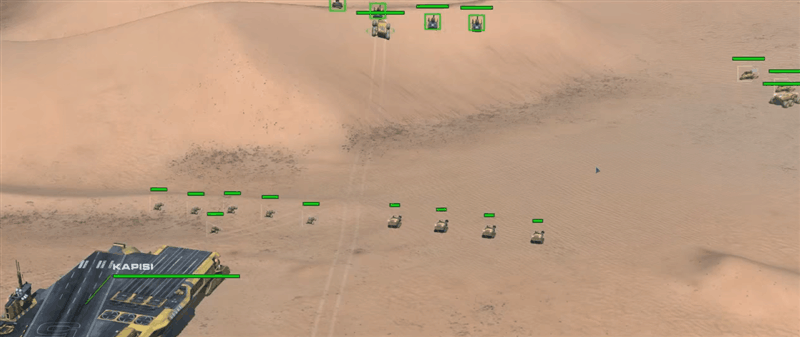
It was also snappy as hell. Which it needed to be, since battles would often develop pretty quickly. The way it married groupings, clear unit class icons and on-point radio chatter meant that in addition to battles developing in front of your eyes, you could also keep track of everything using your ears too.
Sorry if I’ve yammered on about the old Homeworld games for so long when I’m supposed to be talking about a brand new video game, but it’s important to bring up because Deserts of Kharak has all of it. Everything. The at-a-glance icons, the tactical map. It even shadows much of the storyline, with players cast as a small force huddled around a powerful ship, racing through hostile territory with the enemy nipping at their heels.
Only, there’s a big difference. Instead of this game being set in space, and allowing you to move your units along the X Y and Z axis, Deserts of Kharak is set on a planet. With ground, and gravity and a sky.
Any fears that the old formula wouldn’t work on this new landscape are quickly dispelled, though. Deserts of Kharak is one of the best RTS games I’ve played in a long time. Here’s why:
- It paints the desert world of Kharak in the same epic brushstrokes as Relic rendered Homeworld, every cutscene (and yes, they’re the same excellent “2D” cutscenes that Relic’s older games were so good at) packing panoramic black bars, every camera angle panning across a gorgeous landscape. The game wants to tell an epic story, and it’s dressed appropriately.
- The art design, as you’d hope for a Homeworld game, is simply astounding. These are some of the coolest sci-fi unit designs on the planet, and I’ve never wanted a collection of models of something more than I’ve wanted them for this game.
- You’ll see the Unity logo when firing the game up, and aside from some isolated and weirdly inconsistent slowdown issues during cutscenes and battles, this game more than anything else is a showcase as to how damn pretty games can look on this most flexible of engines. The sight of sunset bleeding over some windswept sand dunes, or of smoke billowing from a destroyed carrier, is just ungh.
- It plays almost exactly the same as it’s predecessors. Many of the key commands are the same. The map screen is the same. The way you group units, the way you build them, the way they engage in battle, it’s the same and it’s all just as fun, just as responsive. There are very few RTS games — maybe just Company of Heroes — that are so good in giving you so much to respond to but also giving you all the tools you need to do it quickly. Rarely do you feel overwhelmed; more often you just feel like the most connected and badarse of sci-fi Generals.
- While your larger vehicles will roll to a stop and start unloading their heavy weaponry, the game’s lighter buggies whirl and roll through combat just like Homeworld’s fighters did in deep space. It’s beautiful to watch.
- Deserts of Kharak’s campaign is vintage Homeworld. It’s linear, but every step of the way is written and designed as to actually tell a story, one that does as good a job as a prequel can at setting the stage for events which we already know will transpire.
The whole thing is just…exactly as you’d hope a pitch like this would be. The music. The unit design. The voice acting. It’s all a perfect mix of everything you loved about the old stuff and enough new stuff to make it feel fresh.
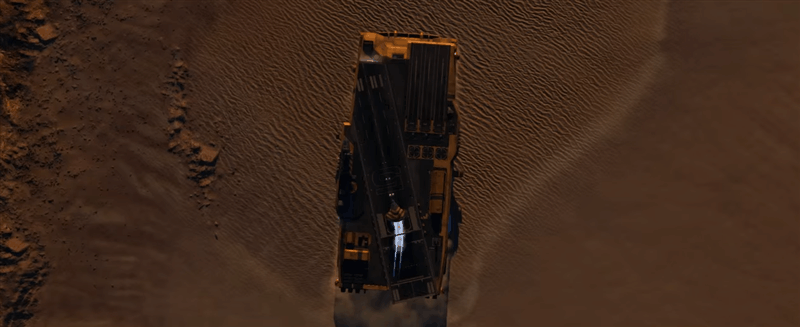

Let’s not get too carried away with the nostalgic revelry though. For all of Homeworld’s pleasures that Deserts of Kharak seamlessly/shamelessly imports, it’s also saddled with some of the series’ frustrations.
Like it’s over-reliance on mission scripting. Like most RTS games everything you build and upgrade in Deserts of Kharak needs money, but unlike most RTS games, resources in this game are thin on the (ahem) ground. Which means that there will come times in the game where you run into a scripted attack which requires a different mix of units than the ones you’ve built (or just more of them), and because you can’t just wait it out and build a new army, you need to reload a save and try a different approach.
The game seems to be aware of this problem, adding a “reload from last checkpoint” option that I don’t remember later Homeworld games having (while also giving players the option of dialling down the difficulty), but still. If you’re going to fail in a strategy game, running into a random dead end that requires a reboot isn’t the ideal way of solving a tactical problem.

But what if you’ve never played Homeworld? Well, firstly, thanks for sticking around while I got through all that stuff for the veterans! And secondly, boy are you in for a treat.
Deserts of Kharak is a fast-paced real-time strategy game that is always keeping you guessing. Rarely do you spend much time sitting around harvesting; the game’s missions are about striking (or reacting) quickly to objectives, and are always throwing you curveballs, forcing you to adapt new positions and strategies on the fly. Yet thanks to a snappy user interface (that map) it manages to feel more like a canvas for new tactics rather than the game simply cheating you.
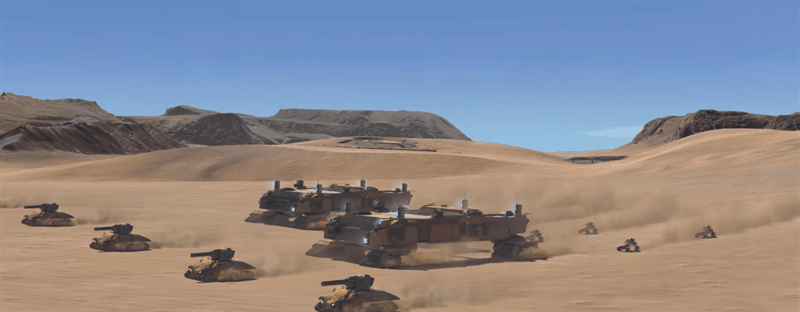
Terrain plays a big part in those tactics. The entire game is set in the desert, which sounds boring, but there’s a fantastic variety in the kinds of desert you encounter, from sandy plains to blockish rock formations to giant craters. The game’s combat uses terrain in two ways: if you’re higher than your opponent you’ve got an attack bonus, and not all units can traverse all areas, so you’ll constantly be dividing your forces for flanking attacks.
You should also know that like the Homeworld games, Deserts of Kharak — and I touched on this briefly above when I spoke about scripting — likes to mess with you during a mission. Almost every single stage in the campaign (which took me 11 hours to complete) will open by giving you an objective, but once that’s completed, you’ll often be presented with an entirely different one which may require a massive shift in your tactics and approach to the stage. It gets a little tiring by the end, but for the most part the surprises are smart and do enough to keep you on your toes.
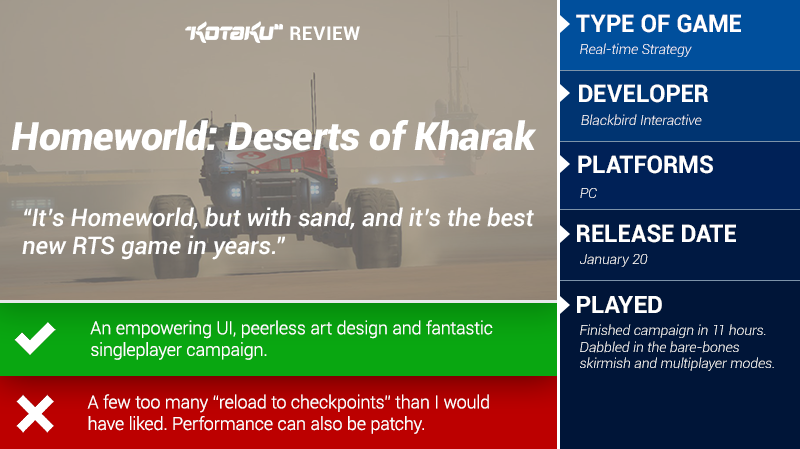

Oh, and I need to talk about the Kapisi. It’s your flagship, your home and salvation throughout your long mission in the desert, and it undergoes one hell of a transformation throughout the course of the game. Initially a vulnerable oaf of a unit that you need to protect at all costs, through the length of the campaign you’ll retrieve upgrades that are scattered throughout the sands. Each one improves the capabilities of the Kapisi, so by the end of the game it’s leading the charge, capable of smashing its way through enemy defences and resulting in some epic confrontations between your carrier and the capital ships of your opponent.
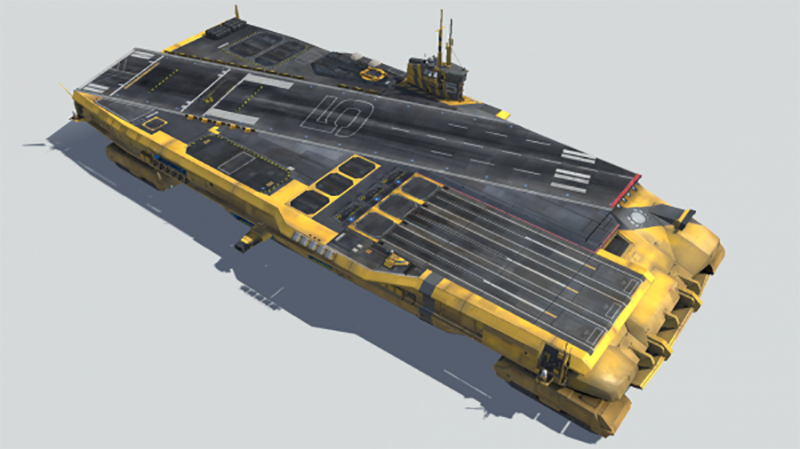
The catch though is that you don’t have enough power to run all of the ship’s main systems (armour, repair, weapons and range) at once, so you have to switch between whatever you need. Or, more often, whatever you want, leaving you free to customise the Kapisi’s loadout to suit your style of play.
The mothership — both base and powerful warship in the same body, and which you had to keep alive at all costs — was always your “pet” in Homeworld, so it’s cool that the Kapisi takes this idea and runs with it, giving you something that by the end you’ve developed a real fondness and attachment to (like you would any good “hero” unit in an RTS).

Everything I’ve said so far applies to the game’s singleplayer campaign, which in keeping with Homeworld tradition is the focus. This is a game about telling a story, and while it ships with some skirmish and multiplayer stuff, there’s not much worth digging into at present, with only a few maps and basic game modes. It…works, I guess, and the skirmish mode could be useful if you’re practicing new tactics, but if you’re big on your PvP stuff with an RTS, this is not the game for you. Anyone looking to squeeze more playtime out of this game would be better served finishing the campaign again on a harder difficulty.
If anything, Deserts of Kharak shows just how good Relic’s original design for Homeworld was, that it can be lifted almost wholesale and dropped in a new setting and it still feels as good as it did over 15 years ago. This is a fast, responsive, smart and not least of all gorgeous strategy game that proves you can (I’m sorry) go Homeworld again (I’m so sorry).
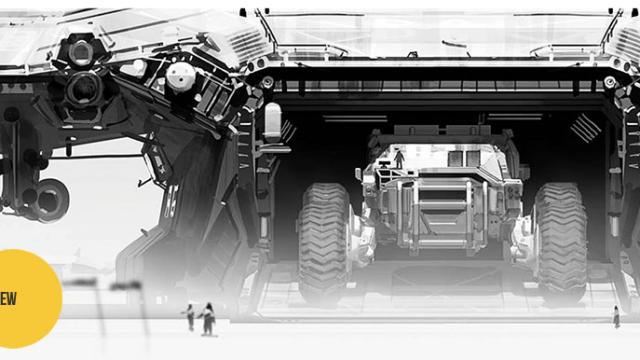
Comments
5 responses to “Homeworld: Deserts Of Kharak: The Kotaku Review”
I’ll have to try this in the near future. I never got a chance to really dive into the original homeworld, but spent a very long time playing with the demo that came with a PC Powerplay many many moons ago. This looks great 😀
Get the remakes on Steam first. They are really, really great.
“Mothership.”
Started playing it last night.
It’s just a damn nostalgia overload.
I’m really enjoying what I’ve played so far…
Also, for those that bought the Homeworld remaster, Gearbox are still working on patches to reintroduce formations that were broken by going to the Homeworld 2 engine. Theu had an announcement that they were close, and showed some screenshots.
I found that I spend more time in the tactical view than I do in the 3D view because the game needs a lot of micro-management of your forces. I’m enjoying it, to a point, but it would be nice if there was a little less need to rely on the tactical map so much.
I’m in Australia and I can’t find this game in store so I asssume its a download, can someone tell me where Ivan get it.
Thanks